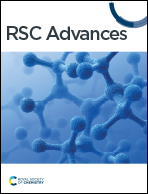Density functional theory study of the corrosion inhibition performance of 6-mercaptopurine and 6-thioguanine expired drugs toward the aluminium (111) surface†
Abstract
The potentiality of the 6-mercaptopurine (MP) and 6-thioguanine (TG) expired drugs toward the corrosion inhibition of the aluminium (Al) (111) surface was widely investigated using a series of density functional theory (DFT) calculations. A competition between the anti-corrosive features of the studied drugs in the gas and aqueous phases was conducted on both neutral and protonated forms by means of quantum mechanical descriptors. The results of the electrostatic potential analysis demonstrated the prominent nucleophilic nature of the sulfur and nitrogen atoms over the structures of the examined drugs. The frontier molecular orbital theory findings outlined the higher preferability of TG over MP as a corrosion inhibitor. Upon determining the most beneficial configurations of the MP/TG⋯Al (111) complexes, first-principles molecular dynamics simulations were executed. Interestingly, the competence of the TG drug in the corrosion inhibition process of Al (111) was more extensive than that of the MP one, which was confirmed by the interaction energy values of −1.79 and −1.64 eV, respectively. Upon obtaining the relaxed complexes, the effect of the presence of water solvent on the adsorption process was studied. These findings provide a foundation for developing green anti-corrosive inhibitors for the aluminium surface.



 Please wait while we load your content...
Please wait while we load your content...